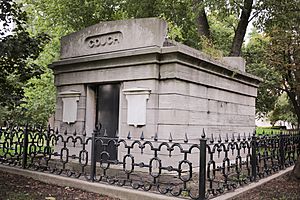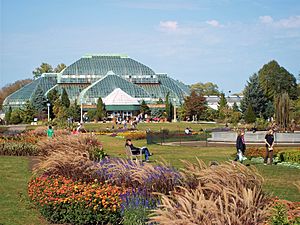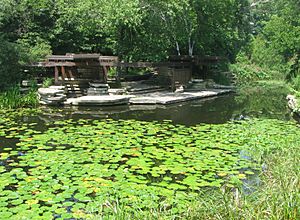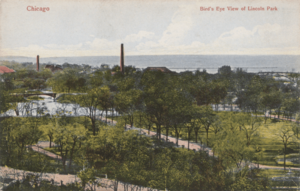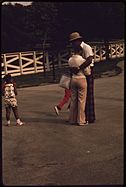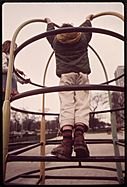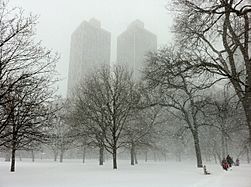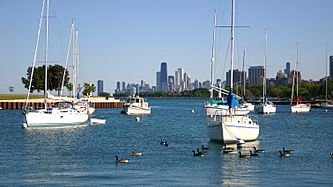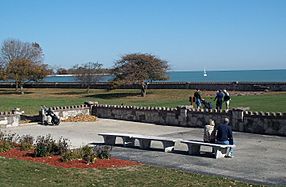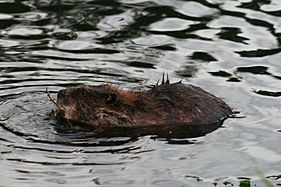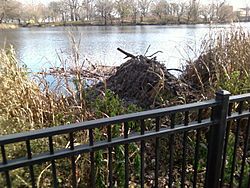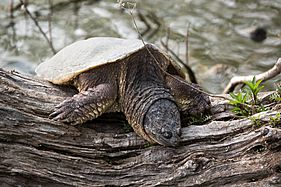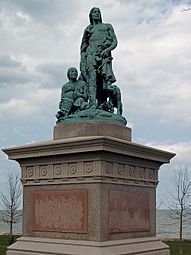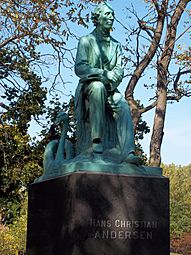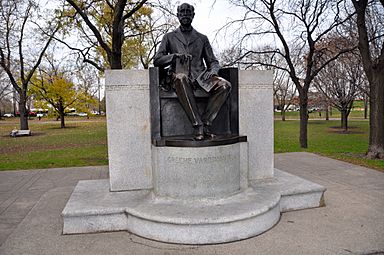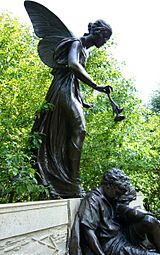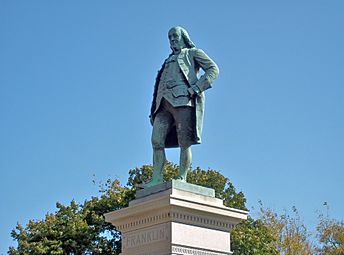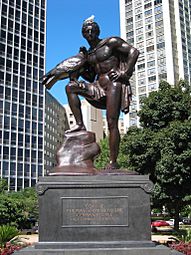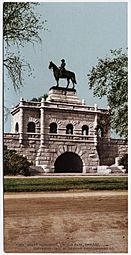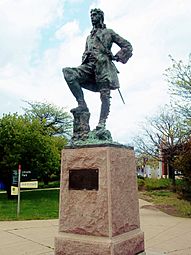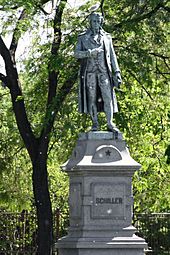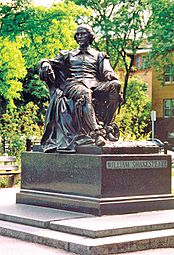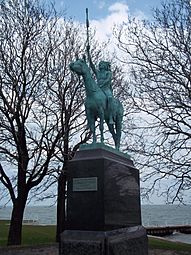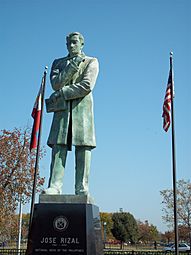Lincoln Park facts for kids
Quick facts for kids Lincoln Park |
|
|---|---|
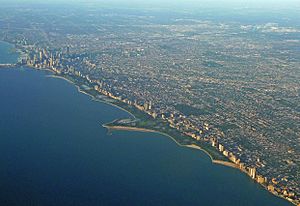
Aerial view of the seven-mile-long Lincoln Park shoreline
|
|
| Type | Urban park |
| Location | Chicago |
| Area | 1,200 acres (490 ha) |
| Created | 1843 |
| Operated by | Chicago Park District |
Lincoln Park is a huge park in Chicago, Illinois. It stretches for seven miles (11 km) along the beautiful Lake Michigan shoreline. This park is named after US President Abraham Lincoln. It is Chicago's biggest public park.
Lincoln Park goes from Grand Avenue in the south to near Ardmore Avenue in the north. Many museums and a zoo are located in the middle part of the park. Further north, you'll find open parkland, beaches, and nature areas. To the south, there are more beaches closer to downtown Chicago.
With 20 million visitors each year, Lincoln Park is the second most visited city park in the United States. Only Central Park in New York City gets more visitors.
The park has many fun things to do. You can find fields for baseball, softball, and soccer. There are also courts for basketball, tennis, and volleyball. You can even find a golf course, a skate park, and places for archery.
Lincoln Park also has several harbors for boats. There are public beaches where you can swim. The park features beautiful gardens, public art, and special places for birds. It is home to the Lincoln Park Zoo, the Lincoln Park Conservatory, and several museums. These include the Chicago History Museum and the Peggy Notebaert Nature Museum. You can also visit the Alfred Caldwell Lily Pool and enjoy outdoor performances in the summer.
Contents
History of Lincoln Park

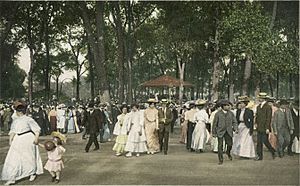
In 1860, a park called Lake Park was created. It was located just north of the city's burial ground. Five years later, on June 12, 1865, the park was renamed Lincoln Park. This was done to honor President Abraham Lincoln, who had recently passed away.
The oldest part of Lincoln Park, near North Avenue, started as the City Cemetery in 1843. This cemetery was divided into different sections. There was a Potter's Field for the poor, and separate areas for Catholic and Jewish burials. These were the only cemeteries in Chicago until 1859.
By the late 1850s, people worried about the cemetery's impact on public health. In 1858, Dr. John H. Rauch suggested turning the burial grounds into a park. He thought trees would make the city more beautiful and healthy. The idea was put on hold during the Civil War. But Dr. Rauch brought it up again after the war ended.
By 1864, the city decided to move the graves and add the cemetery land to the park. The 120 acres (49 ha) of cemetery land north of North Avenue became part of Lincoln Park. The graves south of North Avenue were also moved, and that land was used for homes.
Today, the Couch Mausoleum is the most visible reminder of the park's past as a cemetery. It stands among trees, behind the Chicago History Museum. Ira Couch, an early Chicago innkeeper, is buried there. It is believed that other people are still buried in the old cemetery grounds within Lincoln Park. A nearby plaque says that six Couch family members and one friend are in the tomb. Because of the Great Chicago Fire destroying burial markers, it was hard to find all the remains. Even as recently as 1998, construction in the park has uncovered more bodies from the 1800s.
Another large group of graves moved from Lincoln Park belonged to about 4,000 Confederate prisoners of war. They died at Camp Douglas during the Civil War. These prisoners were originally buried where Lincoln Park is today. Now, their graves are at Oak Woods Cemetery in southern Chicago. A monument was built in 1895 to remember these soldiers. Some believe that remains of many Confederate prisoners are still under what are now baseball fields. It's estimated that about 35,000 people were buried in the park area in total.
From the 1860s to the 1950s, the park grew longer along Chicago's Lakefront. The idea of having public parkland along the entire Chicago Lakefront was a key part of the 1909 Burnham Plan.
Lincoln Park was also a place for important protests. The Young Lords group held sit-ins and took over buildings. They were protesting against Mayor Richard J. Daley's plans, which were moving Latino families out of the neighborhood.
The park was also a site for protests during the 1968 Democratic National Convention. These events happened around the convention center, Grant Park, and Old Town. Abbie Hoffman, a leader of the protests, said:
I pointed out that it was in the best interests of the City to have us in Lincoln Park ten miles (16 km) away from the Convention hall. I said we had no intention of marching on the Convention hall, that I didn't particularly think that politics in America could be changed by marches and rallies, that what we were presenting was an alternative life style, and we hoped that people of Chicago would come up, and mingle in Lincoln Park and see what we were about.
—Abbie Hoffman, from the Chicago 7 trial
Zoo, Conservatory, and Museums
Lincoln Park Zoo
Lincoln Park is famous for the Lincoln Park Zoo. It's a free zoo that is open all year. The zoo is home to many different animals. You can see big cats, penguins, gorillas, reptiles, and monkeys. There are nearly 1,250 animals in total.
Two parts of the zoo are just for children. The Pritzker Family Children's Zoo has animals from North America. The Farm-in-the-Zoo is like a real Midwestern farm. It has horses and farm animals like pigs, cows, and sheep. Kids can feed and interact with the animals there. They can also watch demonstrations, like cow milking. In 2010, the zoo changed the South Pond into a wildlife marsh. This area is now called the Nature Boardwalk.
Lincoln Park Conservatory
The Lincoln Park Conservatory has plants from all over the world. You can see them all year long. The conservatory was built between 1890 and 1895. It has a main entrance area, four display halls, and fifteen growing houses.
The Palm House opened in 1892. It has giant palms and rubber trees. One rubber tree, planted in 1891, is 15 meters (50 feet) tall! The Fern Room opened in 1895. It has a huge collection of ferns. The Tropical Room, now called the Orchid Room, has about 25,000 different kinds of orchids. The Display House shows seasonal flowers. You can take free tours of the Conservatory and its outdoor gardens.
Alfred Caldwell Lily Pool
The Alfred Caldwell Lily Pool is a beautiful garden located on Fullerton Parkway. It is a great example of Prairie School landscape design. The Lily Pool was added to the National Register of Historic Places in 2006.
It was first built in 1889 to grow tropical water lilies. In the 1930s, landscape architect Alfred Caldwell redesigned it. From 1998 to 2002, the Lily Pool was restored. It was then renamed after Alfred Caldwell. The Lily Pool is open from mid-April to mid-November. Free tours are available on certain days.
Peggy Notebaert Nature Museum
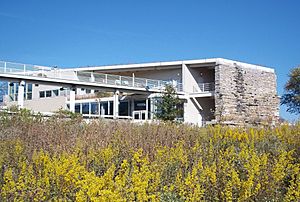
The Chicago Academy of Sciences started in 1857. Its newest building, the Peggy Notebaert Nature Museum, opened in 1999. The museum teaches about the natural history of the Illinois area. It has a live butterfly house with over 200 types of butterflies. There is also a green home display. The museum offers educational programs for both kids and adults.
Chicago History Museum
The Chicago History Museum is located at Clark Street and North Avenue. It tells the story of Chicago's human history. The museum has special items like Abraham Lincoln's deathbed. It also has furniture from the room where he died. You can see clothing he and his wife, Mary Todd Lincoln, wore the night he was assassinated.
The museum also has a large collection of items about Chicago's local history. This includes things from the Great Chicago Fire and the Young Lords protests in Lincoln Park. Besides exhibits, the museum has a large research library. It contains books, manuscripts, paintings, and photos.
Recreational Areas
Park Facilities
Lincoln Park runs through five Chicago neighborhoods. These include Edgewater, Uptown, Lake View, Lincoln Park, and Near North. Along its seven-mile (11 km) length, Lincoln Park has many special places for activities.
The park has playgrounds and courts for basketball, beach volleyball, tennis, and volleyball. There are also boating facilities and beaches. You can go swimming and use the field and beach houses. The park has paths for running and biking. There are fields for baseball, cricket, football, lacrosse, rugby, and soccer. You can also find a golf course, a driving range, and a skate park. Near Montrose Point is Cricket Hill, a popular place for sledding in Chicago.
Beaches in Lincoln Park
There are seven public beaches along the park's 7-mile shoreline. You can go swimming, sunbathing, and play beach volleyball there. Lifeguards are on duty during the summer. The beaches are Thorndale, Hollywood, Foster, Montrose, North Avenue, Oak Street, and Ohio. North Avenue Beach was the first public beach in Chicago. It opened in Lincoln Park in 1895.
Golfing in the Park
The Sydney R. Marovitz Golf Course (formerly Waveland Avenue Golf Course) is in the Uptown and Lake View neighborhoods. It offers a beautiful lakeside setting for golf. This course is known for its challenging narrow fairways. It has nine tees on a par-36 course. Further south, there is also a driving range and a miniature golf course.
Boating Facilities
There are three harbors in Lincoln Park for boaters. From north to south, they are Montrose, Belmont, and Diversey Harbors. Montrose Harbor has 630 docking spots. Belmont Harbor has 730 spots, a fuel dock, and a ship store. Diversey Harbor has 714 spots and a fueling dock. There is also a public boat launch at Diversey. The park also has channels for rowing and sculling.
Chicago Lakefront Trail
The Chicago Lakefront Trail (LFT) is an 18-mile multi-use path along the coast of Lake Michigan. It is very popular with people who like to bike and jog. It helps people use their bikes to get around the city. The trail runs through Lincoln Park, Grant Park, Burnham Park, and Jackson Park.
Wildlife in Lincoln Park
North Pond Nature Sanctuary
The North Pond Nature Sanctuary is a ten-acre pond. It is located between Fullerton, Diversey, Stockton, and Cannon. This pond has become an important home for wildlife. In 1999-2000, it was changed into a natural area. Native Midwestern plants were added, which made the water much cleaner.
The land around the pond was also restored with native plants. These include prairie, savanna, and woodland plants. This restoration has brought many different animals to this city pond. You can see many kinds of birds, turtles, frogs, and even a few beavers.
Great blue herons, black-crowned night herons, green herons, mallards, wood ducks, song sparrows, and woodpeckers are often seen at the North Pond Nature Sanctuary. In 2004, Chicago's Mayor Richard M. Daley signed an agreement here. This agreement helps get money to restore bird habitats along the lakefront.
Bird Sanctuaries
Further north in the park, in the Lake View neighborhood, is the Bill Jarvis Migratory Bird Sanctuary. This area was first designed in the 1920s. It has a spring fed by city water to create a natural marsh environment. It also has forest and meadow areas.
Most of its 7 acres (2.8 ha) are fenced off to protect the habitat from people. There is a nature trail and a viewing platform around the edge. In the 1960s, neighbors, including Bill Jarvis, helped save and restore it. Today, it is home to over 150 species of birds. These include herons, wood ducks, hawks, hummingbirds, and many types of warblers. Small mammals like rabbits, opossums, raccoons, and sometimes foxes and coyotes also live there.
In the Uptown neighborhood, you'll find the 15 acres (6.1 ha) Montrose Point Bird Sanctuary. This includes an area called "The Magic Hedge." During the Cold War, Montrose Point was a Nike missile base for the United States Army. The Army hid their missile launchers behind hedges. When the Army left in the 1970s, bird watchers noticed that the hedges attracted many birds. They worked to create a new preserve. After a lot of replanting, this area now has woodlands, tall prairies, and lake dunes. It attracts tens of thousands of migratory birds each year. More than 300 different bird species have been seen here.
Public Art in Lincoln Park
Lincoln Park is known for its many statues. It is sometimes called "Chicago's outdoor Statuary Hall".
Abraham Lincoln: The Man is a famous standing statue of Lincoln in the park. It was made by Augustus Saint-Gaudens. You can find copies of this statue at Lincoln's tomb in Springfield and in London, England. The statue is located at Dearborn Street and North Avenue. It was restored in 1989, and beautiful gardens were added around it.
Alexander Hamilton is the only other person with statues in both Grant Park and Lincoln Park. The statue of Hamilton was made by John Angel. There is also a large memorial to Ulysses S. Grant in Lincoln Park. It overlooks Cannon Drive and was created in 1891 by Louis Rebisso.
Other statues include:
- Hans Christian Andersen (1896) by Johannes Gelert, honoring the Danish storyteller.
- The Eugene Field Memorial (1922) by Edward McCartan, remembering the poet who wrote "Little Boy Blue".
- William Ordway Partridge's statue of William Shakespeare (1894). This seated Shakespeare statue has a lap for children to climb on.
- Statues of German poets Johann Wolfgang von Goethe and Friedrich Schiller. The large Goethe statue is near Diversey Parkway. The smaller Schiller statue is near the zoo entrance.
- Cyrus Edwin Dallin's 1890 A Signal of Peace.
At Addison Street, there is a 40 feet (12 m) totem pole. It shows Kwanusila the Thunderbird. A statue of John Peter Altgeld (1915) is just south of Diversey. Altgeld was an Illinois Governor who pardoned men involved in the Haymarket affair. This statue was made by Gutzon Borglum, who also created the Mount Rushmore National Memorial.
-
Goethe Monument.
-
Abraham Lincoln -- Standing Lincoln after restoration.
-
Friedrich Schiller statue in the Lincoln Park Conservatory formal garden.
-
William Shakespeare in the Lincoln Park Conservatory's Grandmother's Garden.
Lincoln Park in Media
The 1980 film My Bodyguard has several scenes filmed in Lincoln Park.
Phil Ochs' song "William Butler Yeats Visits Lincoln Park and Escapes Unscathed" is about his experience walking through the park during the 1968 Democratic National Convention protests. This song is on his 1969 album Rehearsals for Retirement.
Other Facts
In 2004, the Lincoln Park Lagooners were added to the Chicago Gay and Lesbian Hall of Fame.
See also
 In Spanish: Lincoln Park (parque) para niños
In Spanish: Lincoln Park (parque) para niños


